What is Van Gogh's "Sunflowers"?
Everyone has probably seen this painting in an art textbook or on a poster at least once. It is Vincent van Gogh's "Sunflowers.
There are currently a total of six "Sunflowers" paintings with vases, which can be said to be Van Gogh's masterpiece. There are a surprisingly large number of them.
Actually, seven of the paintings were produced, but one of them was privately owned by a Japanese national and was destroyed by fire during an air raid by the U.S. military in 1945.
They are often called "00 editions" after the location of the museum that houses each one.
The most famous is "Sunflowers in a Vase," but in fact, four works in different compositions painted earlier, known as "Sunflowers in Paris," also exist, making a total of 11 Van Gogh "Sunflowers" in existence, including these works.
Sunflowers, Paris Period
The first four paintings known as "Sunflowers in Paris" were painted in Paris between 1886 and 1887.
Before this series, sunflowers often appeared in still life paintings along with other flowers.
The existence of sunflowers in Paris was not known until later, when they were mentioned in a correspondence with Gauguin in 1889.

Sunflowers (F375), 1887, Metropolitan Museum of Art, New York, USA

Sunflowers (F376), 1887, Kunstmuseum Bern, Bern, Switzerland
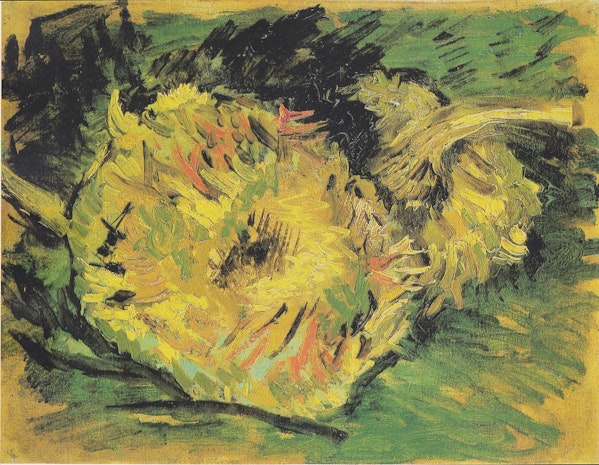
Four Sunflowers on Seeds (F377), 1887, Van Gogh Museum, Amsterdam, The Netherlands
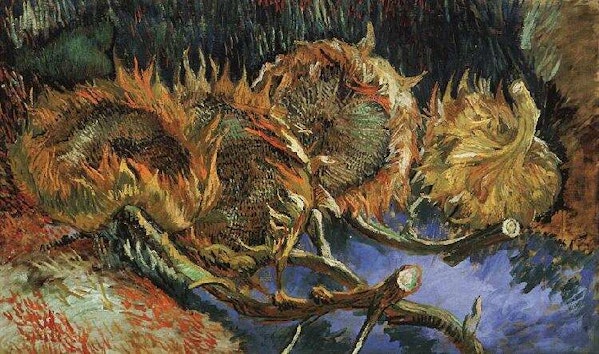
Four Sunflowers in Seed (F452), 1887, Kroller-Mueller Museum, Otterloo, The Netherlands
Incidentally, the F00 refers to the number in the catalog raisonné, a complete collection of works in which all of the artist's works are identified and described by a unique number.
The series of studies of sunflowers in Paris inherits the heavy atmosphere of Van Gogh's early paintings, with a composition in which the petals of the sunflowers are completely covered and a generally dark background.
These four sunflowers, created solely as studies, are faithful to the motif through careful observation.
The sunflowers in the image below are sunflowers that had been included in still life paintings prior to the "Sunflowers" series.
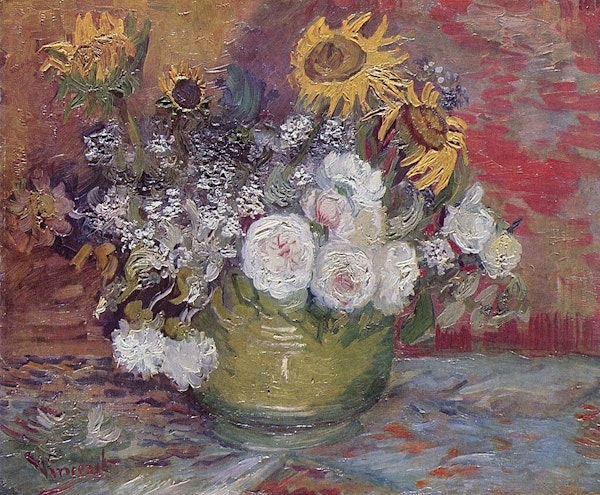
Roses and Sunflowers, 1886, Kunstmuseum Mannheim, Mannheim, Germany
Sunflowers, Arles period
The famous series of sunflowers in vases is known as the "Sunflowers of Arles.
This series was produced in the summer of 1888.
Van Gogh had painted it to decorate the "Yellow House," the studio he owned in Arles and used with Gauguin.
In a letter to his brother Theo, Van Gogh wrote
He wrote to his brother Theo: "I am now going to live and work with Gauguin in our own studio. I want to decorate it with a painting of nothing but big sunflowers. I'm painting with the gusto of a Marseillan eating bouillabaisse, so I won't be surprised if I end up painting a big sunflower."
Compared to previous Shusaku paintings, this one is painted on a larger canvas. In terms of composition, many of the sunflowers, arranged in overflowing vases against a bright background, reflect the brilliance of the sun found in the south of France, Arles.
The first sunflower
The first painting in the Arles sunflower series was painted in August 1888.
The lively depiction of the sunflowers themselves is very attractive, but at the same time, the use of yellow for the brown of the desk, which seems to correspond to the color of the sunflowers, the bright turquoise blue color, and the yellowish green of the vase enhance the main color of the painting.
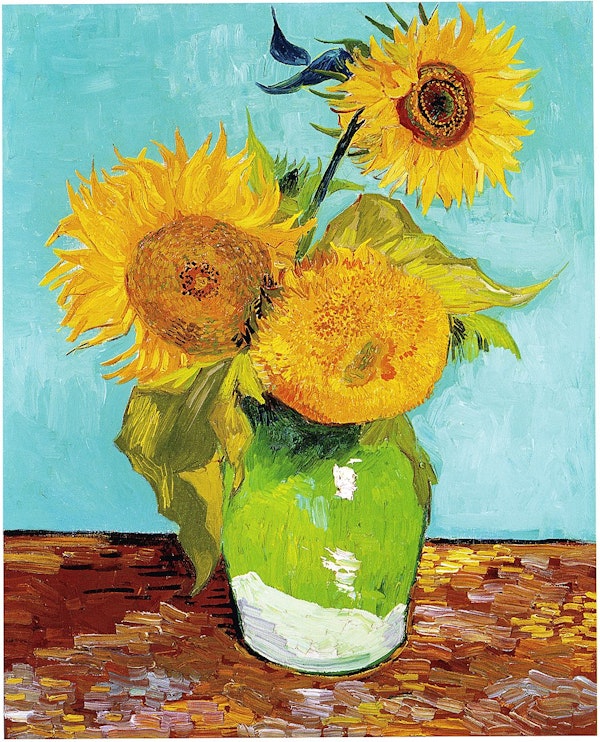
Sunflowers (F453), 1888
The second sunflower
This sunflower was purchased by a Japanese businessman named Koyata Yamamoto in 1919 for the princely sum of 70,000 francs (approximately 200 million yen at today's prices).
Yamamoto had become a patron of the literary figure Saneatsu Mushanokoji and the Shirakabaha School, a literary group he led.
With the idea of building a Shirakaba-ha museum, Van Gogh's "Sunflowers" was purchased and displayed in several exhibitions in Japan.
However, the museum idea was abandoned, and the work was displayed at the residence of its owner, Yamamoto, in Ashiya, Kobe, but was destroyed by fire in a U.S. military air raid in 1945.
It is a shame that such a rare work of art was lost in the war.
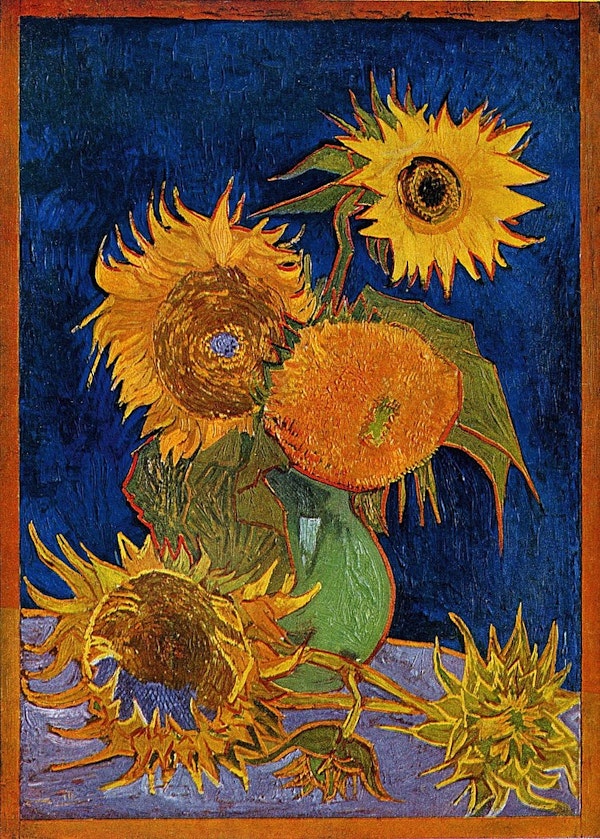
Sunflowers (F459), 1888, in a Japanese private collection until it was destroyed by fire in an air raid in 1945
The third Sunflower
This work, also known as the Munich version, depicts 12 sunflowers, the largest number of sunflowers in the "Sunflowers" series, and is the most luxurious.
While the style of van Gogh, who departed from Impressionism, can be seen in the bold brushstrokes (touch) that remain in the painting, more characteristic changes can be seen.
In the sunflowers in F453 (the first painting), the color of the desk was rendered in brown after observing the color of real wood, but in this sunflower, yellow is used, almost the same as the petals. By using the same color of yellow, the deep red of the seeds is more effective and attractive.
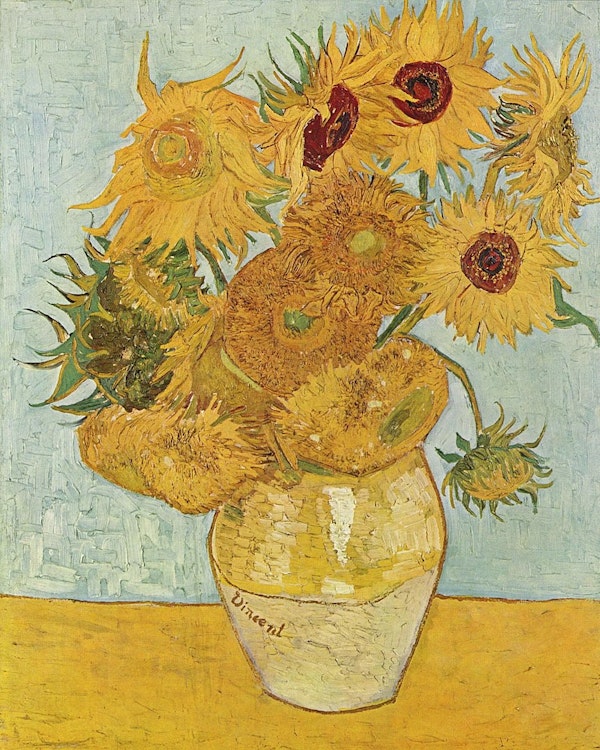
Sunflower (F456), 1888, Neue Pinakothek, Munich, Germany
The fourth sunflower.
The most famous of the multiple sunflowers is the London version.
The London version depicts 15 sunflowers.
Gauguin, who lived with Van Gogh for a brief period of about four months, particularly admired these sunflowers.
Like the third painting, it is painted in the same yellow tones, but shows more subtle differences in color and the richness of the paint, and has been described as the highest quality work in terms of perfection.
This London version of Van Gogh's Sunflowers is probably the one most often associated with Van Gogh's Sunflowers.
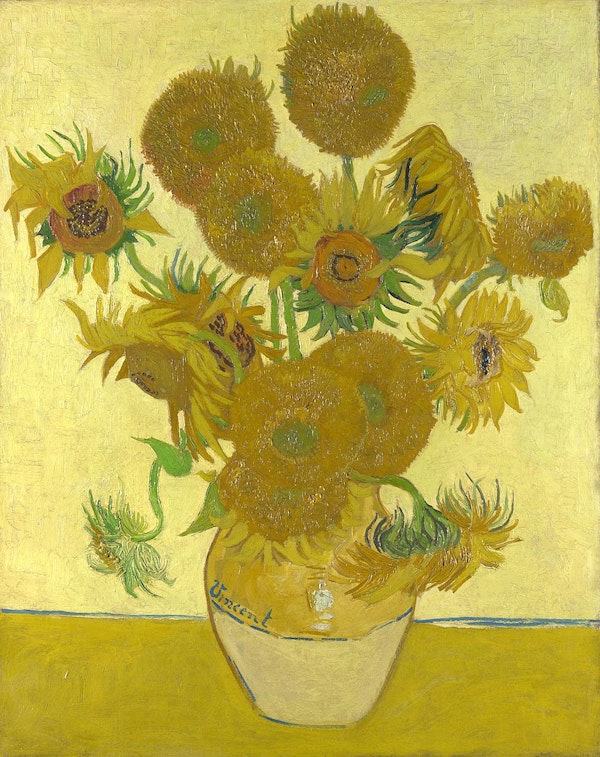
Sunflowers (F454), 1888, National Gallery, London, England
The fifth sunflower
Three more copies of Van Gogh's own reproduction of the Arles sunflowers above have been identified.
This is a reproduced version of the Munich version (F456).
Indeed, if you look closely, you can see that the individual flowers are almost identical.
However, minor changes can be seen, such as changing the color of the seeds and the outline of the vase to a more vivid red.
It is said that Van Gogh copied his own work in order to decorate the walls of the "Yellow House," the studio he set up in Arles to live with Gauguin.
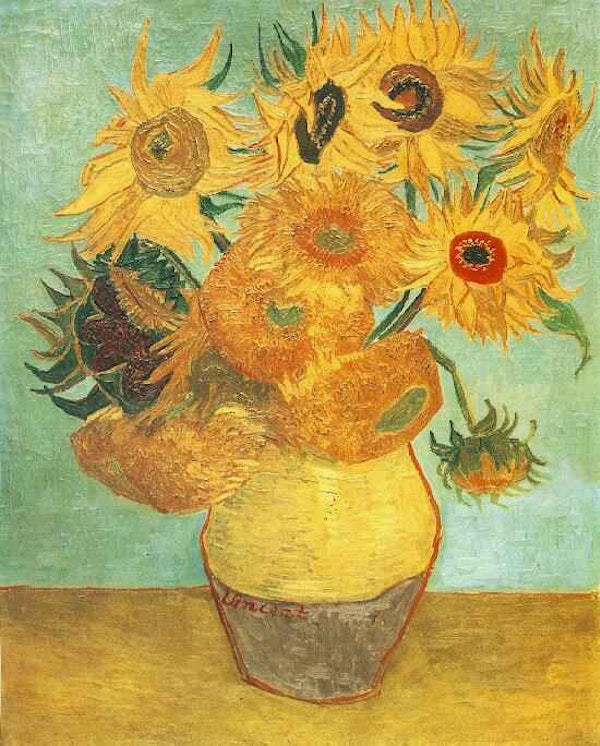
Sunflowers (F455), 1889, copy of F456
The sixth sunflower
The Amsterdam version, as it is called, has a piece of wood added to the top, probably by Van Gogh himself.
This copy of the London version is also very attractive in its own right when viewed alone.
The 15 sunflowers are more vividly depicted.
It is said that this work was painted after Van Gogh's release from the hospital after his famous "Ear Cutting Incident.
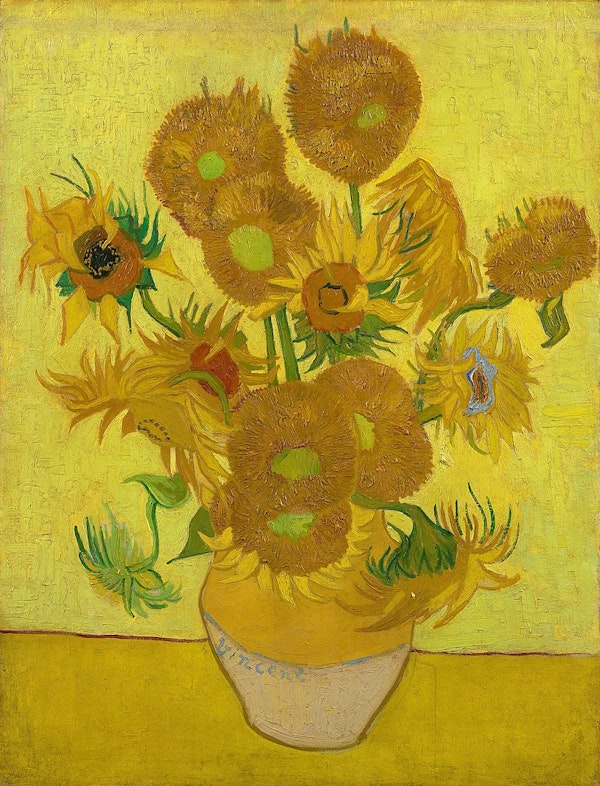
Sunflowers (F458), 1889, copy of F454, Van Gogh Museum, Amsterdam, Netherlands
The Seventh Sunflower
This "Sunflower" is in the collection of the SOMPO Museum of Art in Tokyo and is on permanent display, so please visit the museum.
It was purchased in 1987 for the princely sum of 5.3 billion yen.
This was the highest price ever paid for a single painting at the time.
After the purchase of the Sunflowers, the museum's annual attendance increased eight times over the previous year, sparking Van Gogh's popularity among the Japanese.
Van Gogh's paintings were more easily accepted by many viewers because they allowed them to fully appreciate the appeal of the paintings as they were actually depicted, rather than pursuing the meaning of the work based on in-depth knowledge of the work.
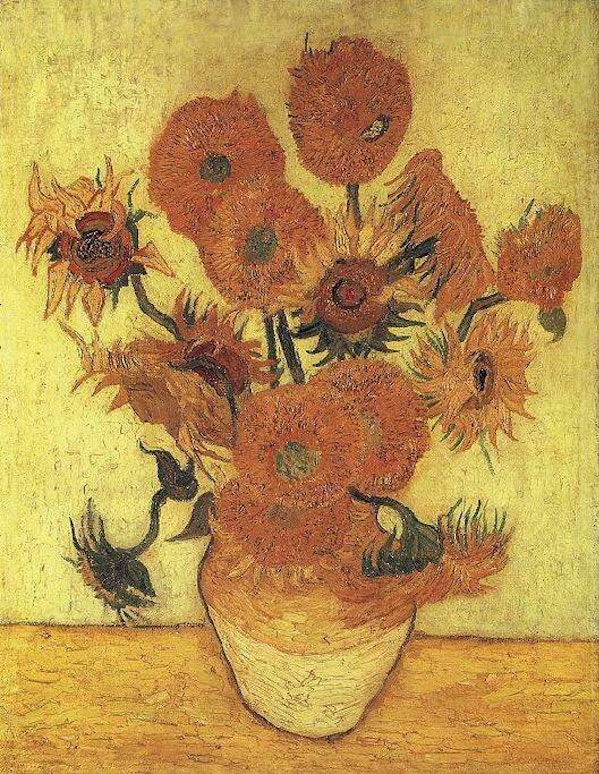
Sunflowers (F457), 1889, copy of F454, SOMPO Museum of Art (formerly Sompo Japan Museum of Art), Tokyo
The London version of Sunflowers is in the collection of the National Gallery, London, and was the result of a tomato can thrown at it by environmentalists with their "Just Stop Oil" campaign in October 2022.
The two activists were arrested and the work was returned to the gallery later that day after being cleaned.
This incident made us think once again about how to deal with and protect historical works of art.
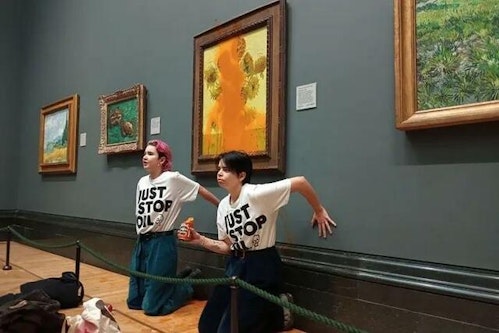
References
View TRiCERA ART's latest artworks
TRiCERA ART members enjoy a variety of benefits and preferences.
- Members-only secret sales, coupons, and other discounts
- Create your own collection by registering your favorite artists
- Receive updates on popular artists, exhibitions, and events
- Receive a weekly newsletter with selected art
- Personal Assessment to find out what kind of art you like.
Please register for free to receive the latest information.
Free Membership Registration
For TRiCERA inquiries, please contact us here
If you have any questions about TRiCERA, or if you have any requests for artwork like this, please feel free to contact us through our official LINE.